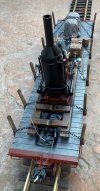Andreas
Registered
Hello together,
Here are my experiences: I have only had an inherited garden track for 6 months. All locomotives are controlled digitally with Massoth. Since I want to play and not build a 1:1 copy of the world, this system is too complicated for me.
I have equipped 2 locomotives with battery and control from Fosworks (and My Locosound). The points are set by hand. Uncoupling is also done by hand with the help of a wooden spatula (like doctors have to look into the mouths). This is the solution for me - as long as I am still fit.
It is simple and reliable. The CV programming drove me crazy. I spent hours on it only to realise that the decoder was not working properly and had a partial defect.
I found my way with Fosworks and manual work.
Here are my experiences: I have only had an inherited garden track for 6 months. All locomotives are controlled digitally with Massoth. Since I want to play and not build a 1:1 copy of the world, this system is too complicated for me.
I have equipped 2 locomotives with battery and control from Fosworks (and My Locosound). The points are set by hand. Uncoupling is also done by hand with the help of a wooden spatula (like doctors have to look into the mouths). This is the solution for me - as long as I am still fit.
It is simple and reliable. The CV programming drove me crazy. I spent hours on it only to realise that the decoder was not working properly and had a partial defect.
I found my way with Fosworks and manual work.




